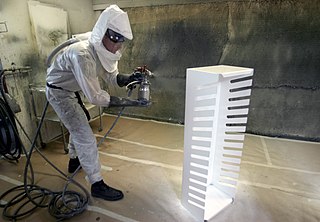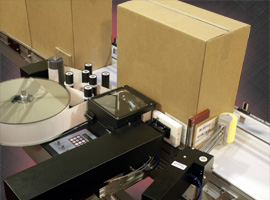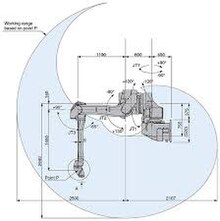
Paint is any pigmented liquid, liquefiable, or solid mastic composition that, after application to a substrate in a thin layer, converts to a solid film. It is most commonly used to protect, color, or provide texture. Paint can be made in many colors—and in many different types. Paint is typically stored, sold, and applied as a liquid, but most types dry into a solid. Most paints are either oil-based or water-based and each has distinct characteristics. For one, it is illegal in most municipalities to discard oil-based paint down household drains or sewers. Clean-up solvents are also different for water-based paint than they are for oil-based paint. Water-based paints and oil-based paints will cure differently based on the outside ambient temperature of the object being painted. Usually, the object being painted must be over 10 °C (50 °F), although some manufacturers of external paints/primers claim they can be applied when temperatures are as low as 2 °C (35 °F).

An industrial robot is a robot system used for manufacturing. Industrial robots are automated, programmable and capable of movement on three or more axes.

Spray painting is a painting technique in which a device sprays coating material through the air onto a surface. The most common types employ compressed gas—usually air—to atomize and direct the paint particles.

FANUC is a Japanese group of companies that provide automation products and services such as robotics and computer numerical control wireless systems. These companies are principally FANUC Corporation of Japan, Fanuc America Corporation of Rochester Hills, Michigan, USA, and FANUC Europe Corporation S.A. of Luxembourg.

A car wash, carwash, or auto wash is a facility used to clean the exterior, and in some cases the interior, of cars. Car washes can be self-service, full-service, or fully automated. Car washes may also be events where people pay to have their cars washed by volunteers, often using less specialized equipment, as a fundraiser.

Robot welding is the use of mechanized programmable tools (robots), which completely automate a welding process by both performing the weld and handling the part. Processes such as gas metal arc welding, while often automated, are not necessarily equivalent to robot welding, since a human operator sometimes prepares the materials to be welded. Robot welding is commonly used for resistance spot welding and arc welding in high production applications, such as the automotive industry.

Powder coating is a type of coating that is applied as a free-flowing, dry powder. Unlike conventional liquid paint which is delivered via an evaporating solvent, powder coating is typically applied electrostatically and then cured under heat or with ultraviolet light. The powder may be a thermoplastic or a thermoset polymer. It is usually used to create a hard finish that is tougher than conventional paint. Powder coating is mainly used for coating of metals, such as household appliances, aluminium extrusions, drum hardware, automobiles, and bicycle frames. Advancements in powder coating technology like UV curable powder coatings allow for other materials such as plastics, composites, carbon fiber, and MDF to be powder coated due to the minimum heat and oven dwell time required to process these components.
A rotary atomizer is an automatic electrostatic paint applicator used in high volume, automatic production painting environments. Also called a 'paint bell', "rotary bell atomizer" or 'bell applicator', it is preferred for high volume paint application for its superior transfer efficiency, spray pattern consistency, and low compressed air consumption, when compared to a paint spray gun. It can be mounted in a fixed position, reciprocating arm, or an industrial robot.

A label printer applicator is a basic robot that can automatically print and apply pressure-sensitive labels to various products. Some types of labeling include shipping labeling, content labeling, graphic images, and labeling to comply with specific standards such as those of GS1 and Universal Product Code U.P.C. A pressure-sensitive label consists of a label substrate and adhesive.

A spray nozzle or atomizer is a device that facilitates the dispersion of a liquid by the formation of a spray. The production of a spray requires the fragmentation of liquid structures, such as liquid sheets or ligaments, into droplets, often by using kinetic energy to overcome the cost of creating additional surface area. A wide variety of spray nozzles exist, that make use of one or multiple liquid breakup mechanisms, which can be divided into three categories: liquid sheet breakup, jets and capillary waves. Spray nozzles are of great importance for many applications, where the spray nozzle is designed to have the right spray characteristics.

Sheen is a measure of the reflected light (glossiness) from a paint finish. Glossy and flat are typical extreme levels of glossiness of a finish. Gloss paint is shiny and reflects most light in the specular (mirror-like) direction, while on flat paints most of the light diffuses in a range of angles. The gloss level of paint can also affect its apparent colour.

Automotive paint is paint used on automobiles for both protective and decorative purposes. Water-based acrylic polyurethane enamel paint is currently the most widely used paint for reasons including reducing paint's environmental impact.

Graco is an American industrial company specializing in the development and manufacturing of fluid-handling systems and products. The company is headquartered in Minneapolis, Minnesota and markets its products to customers worldwide.

Vibratory bowl feeders, also known as a bowl feeders, are common devices used to orient and feed individual component parts for assembly on industrial production lines. They are used when a randomly sorted bulk package of small components must be fed into another machine one-by-one, oriented in a particular direction.
Xylan is a fluoropolymer-based industrial coating, most commonly used in non-stick cookware. Generally, it is applied in a thin film to the target material to improve its durability and non-stick properties.
A film applicator is a device used to evenly spread a substance, such as paint, ink, or cosmetics, over a substrate such as a drawdown card.

Packaging machinery is used throughout all packaging operations, involving primary packages to distribution packs. This includes many packaging processes: fabrication, cleaning, filling, sealing, combining, labeling, overwrapping, palletizing.
A composite bearing is a bearing made from a combination of materials such as a resin reinforced with fibre and this may also include friction reducing lubricants and ingredients.
Rotary atomizers use a high speed rotating disk, cup or wheel to discharge liquid at high speed to the perimeter, forming a hollow cone spray. The rotational speed controls the drop size. Spray drying and spray painting are the most important and common uses of this technology.
















